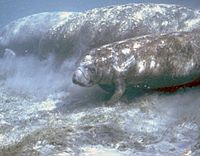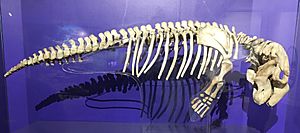Sirenia facts for kids
Quick facts for kids SireniaTemporal range: Early Eocene – Recent
|
|
|---|---|
 |
|
| West Indian Manatees (Trichechus manatus) | |
| Scientific classification | |
| Kingdom: | |
| Phylum: | |
| Class: | |
| Infraclass: | |
| Superorder: | |
| Order: |
Sirenia
|
The Sirenia, commonly referred to as sea-cows or sirenians, are an order of fully aquatic, herbivorous mammals that inhabit swamps, rivers, estuaries, marine wetlands, and coastal marine waters. The Sirenia currently comprise the families Dugongidae (the dugong and, historically, Steller's sea cow) and Trichechidae (manatees) with a total of four species. The Protosirenidae (Eocene sirenians) and Prorastomidae (terrestrial sirenians) families are extinct. Sirenians are classified in the clade Paenungulata, alongside the elephants and the hyraxes, and evolved in the Eocene 50 million years ago. The Dugongidae diverged from the Trichechidae in the late Eocene or early Oligocene.
Sirenians grow to between 2.5 and 4 metres (8.2 and 13.1 feet) in length and 1,500 kilograms (3,300 pounds) in weight. The now extinct Steller's sea cow was the largest sirenian to have lived, and could reach lengths of 8 metres (26 feet) and weights of 8 to 10 metric tons (8.8 to 11.0 short tons). Sirenians have a large, fusiform body to reduce drag through the water. They have heavy bones that act as ballasts to counteract the buoyancy of their blubber. They have a thin layer of blubber and consequently are sensitive to temperature fluctuations, which cause migrations when water temperatures dip too low. Sirenians are slow-moving, typically coasting at 8 kilometres per hour (5.0 miles per hour), but they can reach 24 kilometres per hour (15 miles per hour) in short bursts. They use their strong lips to pull out seagrasses, consuming 10–15% of their body weight per day.
While breathing, they hold just their nostrils above the surface, sometimes standing on their tails to do so. Sirenians typically inhabit warm, shallow, coastal waters, or rivers. They are mainly herbivorous, but have been known to consume animals such as birds and jellyfish. Males typically mate with more than one female (polygyny), and may participate in lek mating. Sirenians are K-selected, and display parental care.

The meat, oil, bones, and skins are valuable items sold in markets. Mortality is often caused by direct hunting by humans or other human-induced causes, such as habitat destruction, entanglement in fishing gear, and watercraft collisions. Steller's sea cow went extinct due to overhunting in 1768.
Taxonomy
- Order Sirenia
- Family Dugongidae
- Dugong, Dugong dugon
- †Steller's sea cow, Hydrodamlis gigas
- Family Trichechidae
- West Indian manatee, Trichechus manatus
- African manatee, Trichechus senegalensis
- Amazonian manatee, Trichechus inunguis
- Family Dugongidae
Images for kids
-
Cladogram showing the estimated times of divergence between sirenian taxa
See also
 In Spanish: Sirenios para niños
In Spanish: Sirenios para niños






